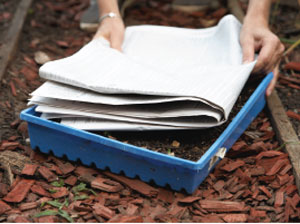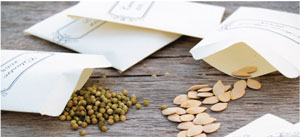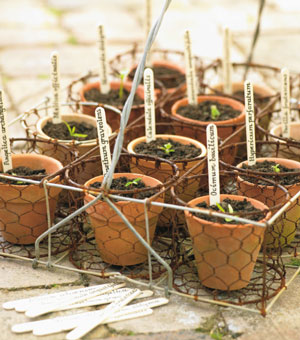
Sowing seed
Source seeds through plants grown in the garden or buy seed packets sold through nurseries or mail-order companies or websites. Collecting seed from the garden is the cheapest way, of course; however, there’s very little guarantee that plants will come true from seed, as certain herbs may cross-pollinate or simply not represent the parent plant. For ease of growing, particularly for new gardeners, packet seeds provide good value and instructions that indicate when, how and where to plant. In addition, the plants will be true to type and available in the right season
The required depth of planting will vary, depending on seed size. In general, the finer the seed, the shallower it should be sown; sowing at a depth of about twice the diameter of the seed is a good rule of thumb. It’s easier to spread fine seeds such as marjoram, savory and thyme more evenly if you mix them with a little sand.
When to sow
When you plant your seeds will depend on your climate and the advice given on the seed packet. If your chosen seeds take six to eight weeks to germinate, start them indoors or in a glasshouse about this far ahead, before the final frosts.
Once the good spring weather starts, the seedlings will be ready to transplant. Some annual herbs can be sown successfully in autumn but, to achieve best results, follow the packet instructions.
Sow seeds in cell packs or seed trays, in individual pots or in situ. Herbs that don’t transplant well, because disturbing their roots encourages them to “bolt” (flower prematurely), are best planted either directly in the garden or in large pots. These include borage, coriander, dill, chervil, fennel and summer savory.
To add interest and colour to paved areas, paths or retaining walls, fill cracks, crevices or nooks with potting mix and sow seeds of compact or trailing plants such as nasturtium, sweet violet and different varieties of thyme.
Sowing seeds under cover
Other seeds, such as coriander and verbena, need to be in the dark until
they’ve germinated. Block out the light by covering the seed trays with
sheets of newspaper and store in a dry, warm place.
Soaking seeds in warm water overnight before planting will also help basil and parsley to germinate, while other seeds need to be stratified by refrigerating them with moist sterile sand or vermiculite in a
sealed plastic bag for a month. Once seedlings appear, prick them out.
Thin out the rows by transplanting the seedlings to larger containers
or individual pots. Use a wooden skewer to gently ease the delicate roots out, then carefully handle the seedlings by the leaves.
Seed-raising mix
The growing medium plays a critical role in plant propagation. The tiny
roots of new plants need to be able to grow in a lightweight material that provides support, air pockets, moisture and good drainage. Potting
mixes are developed especially for propagation and are usually sold as
seed-raising mix or propagation mix.
The ingredients may include:
SAND Coarse river sand, not fine brickies’ sand, is best to ensure good drainage.
VERMICULITE This lightweight silicate material has been heated so it
expands, soaks up water and attracts important nutrients.
PERLITE Derived from volcanic rock that has also been mined and heated, it is used to aerate soil and improve drainage.
COCONUT FIBRE, coco-peat or coir. This is a natural waste product with
excellent water-holding properties. It’s used in gardening products instead of peat moss, which is a nonrenewable natural resource.
Raising seeds
Keep seeds and seedlings moist but don’t overwater them. Seeds, in particular, need to be kept damp but must not be soggy. Once plants dry out, their germination will be stunted or even stop. It’s important to water the seed tray gently. Either lightly mist the mix with a spray bottle or damp it before planting. Or water the tray from the bottom so the moisture can be drawn up.
Fertilising
Once seedlings begin to emerge, give them just a half-strength solution of an all-purpose soluble fertiliser. Later, once you have transplanted them, increase the dosage, but remember plants can absorb only so much.
Heat
Warmth is also an important factor for germination and you can provide artificial heat in a number of ways. Try heating trays from the base with
purpose-built electrical heat packs, heat mats or even hot-water bottles.
You can also purchase portable glasshouses through nurseries and mail-order suppliers. These compact PVC greenhouses are lightweight
and easy to assemble and come in various sizes so you can position them against an outdoor wall or even on a balcony. Propagators are portable trays, like a minigreenhouse, and are also sold by nurseries. Alternatively, place seed trays by a sunny window, in a warm kitchen or outdoors in a warm, frost-free location.
Posible problems
- 1. Damping of is a fungal disease that thrives in cool or cold, damp or overcast conditions. The best way to prevent this is to keep seed trays in a location with good air circulation, light and warmth, although you could also try watering the seedlings with chamomile tea, an old herbal remedy. If a white mould appears in spite of your best efforts, discard
the mix and transplant the seeds or seedlings into new sterilised containers. - 2. Seedlings become leggy when there is not enough light or the conditions are overcrowded. Simply move the tray to a brighter spot and thin out the seedlings by cutting the unwanted seedlings at the base. If you pull them out, you run the risk of disturbing the roots of the others.



